VOLUME 18 (Supplement)

SciEnggJ 18 (Supplement) 107-119
available online: 15 May 2025
DOI: https://doi.org/10.54645/202518SupLFF-84
*Corresponding author
Email Address: kppaglingayen@up.edu.ph
Date received: 17 July 2024
Dates revised: 03 October 2024
Date accepted: 08 December 2024
ARTICLE
Bacterial pathogens of non-native rodents and shrews of Busol Watershed and Forest Reservation, Baguio City
Philippines Baguio, Governor Pack Road, Baguio City 2600,
Philippines
In the Philippines, small mammal infections are poorly studied and are limited to zoonotic pathogens. To assess potential infectious threats to native non-volant mammal species within the Busol Watershed and Forest Reservation (BWFR), the pathogenic bacteria in synanthropic rodents and shrews were investigated using 16S rRNA gene sequencing. Potential transmission pathways of these pathogens were also studied through phylogenetic analyses and literature review. Twenty-seven non-native rodents and shrews were captured (12 Suncus murinus, 11 Rattus exulans, and four (4) R. tanezumi) and screened for putative bacterial pathogens. Eight (8) pathogenic bacterial phylotypes were identified: Morganella morganii, Ehrlichia japonica, Exiguobacterium aurantiacum, Clostridium neonatale, Corynebacterium phoceense, Campylobacter curvus, Spodiobacter cordis, and Ralstonia sp. The S. cordis and Ralstonia sp. were detected in the pooled blood and fecal samples, respectively. The presence of Ralstonia in feces suggests transmission through environmental exposure. Statistical tests also showed that the pathogen prevalence and dissimilarity had no association with host species, sex, and maturity, indicating that these are not linked to higher infection risks. This was also supported by the phylogenetic analyses wherein obtained sequences did not form distinct clades with genotypes associated with single host species. This study posits that synanthropic rodents and shrews in BWFR harbor pathogenic bacteria capable of cross-species transmission. Investigating these transmissions is important in predicting infection dynamics among small, non-volant mammal and human populations and the pathogen exposure risk of native mammal species within the BWFR.
© 2025 SciEnggJ
Philippine-American Academy of Science and Engineering